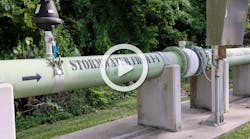Increasing Population Boosts Hazardous Contamination
About the author: Caitlin Cunningham is managing editor of Storm Water Solutions. Cunningham can be reached at 847.391.1025 or by e-mail at [email protected].
The number of no-swim days at U.S. beaches more than doubled between 2005 and 2006, according to the National Resources Defense Council’s (NRDC) 17th annual beach water quality report, “Testing the Waters: A Guide to Water Quality at Vacation Beaches.” In 2006, health advisory and closure days at ocean, bay and Great Lakes beaches totaled more than 25,000—a survey record.
Tourists, recreation users, shoreline residents and government officials can place much of the blame for dangerously elevated bacteria levels on storm water management issues. The NRDC report cites runoff from impervious surfaces as the largest contributor to our nation’s beach pollution and, thus, related advisories and closures.
Population Overload
A key contributor to increasing impervious pavement coverage and thus the U.S. storm water runoff problem is an ongoing coastal population boom. A June 2006 Scientific America article analyzed the beach pollution and local population correlation in detail, noting that millions of Americans have moved to coastal regions—particularly the Southeast shoreline—in recent years to take advantage of their climate, scenery and recreational opportunities.
In fact, the most recent National Oceanic and Atmospheric Administration coastal population trends report stated that more than half of the U.S. population lives along narrow coastal fringes that account for only 17 percent of the nation’s contiguous land area. The group also predicted that by year’s end, approximately 7 million more people will join coastal county populations.
To accommodate rising inhabitant numbers, coastal communities are rapidly constructing new roadways, parking lots and residential and business sites. The Scientific America article goes on to explain that this speedy and often poorly planned impervious pavement-dominated development is corrupting natural drainage systems and leaving beaches contaminated with disease-causing microorganisms. Contaminants once filtered out in forests and wetlands now find their way into designated swimming beach areas and other important water resources.
Surrounding issues (i.e., public health, drinking water quality, tourism and real estate values) come into play when one considers the impact of beach water pollution.
A Town Takes Action
Bearing these matters in mind, officials and residents in the coastal community of Kure Beach, N.C., invested in a February 2006 storm water project to prevent runoff from reaching and polluting its beach waters. Underground storm water storage and infiltration systems designed by the North Carolina State University (NCSU) Department of Biological and Agricultural Engineering and paid for by the North Carolina Department of Transportation (NCDOT) were implemented to help divert rainwater into beach dunes.
The outfall pipes in Kure Beach gather runoff from impervious surfaces such as Highway 421 and other roads, parking lots, driveways and rooftops. The town considered diverting the runoff to nearby but discreet U.S. Army-owned wetlands, but this plan proved too costly, according local newspaper the Island Gazette. Kure Beach leaders opted instead to divert a portion of the tainted water, via two storm water infiltration systems, into the dunes.
The new system utilizes StormChamber, manufactured by HydroLogic Solutions Inc., Occoquan, Va., to help keep the beach community clean and compliant with increasingly stringent storm water regulations. The underground, open-bottomed plastic chambers encourage storm water infiltration and groundwater recharge. The chambers’ design helps them remove sediment, phosphorous, nitrogen and other runoff pollutants. In the Kure Beach project, 12 chambers were installed on one site and 22 on another to handle small, frequently occurring rainfall events, thus keeping beaches safe and open.
An NCSU follow-up report indicates that the dune infiltration systems captured 96.6 percent of runoff produced during 25 storm events from March through October 2006. Inflowing runoff had a median fecal coliform concentration of 7,600 colony forming units (cfu)/100 mL and a median enterococcus concentration of 1,298 cfu/100 mL. In groundwater, the fecal coliform concentration median measured 1.5 cfu/100 mL and the enterococcus concentration median 10 cfu/100 mL. NRDC recognized Kure Beach as a “Beach Buddy” in its 2007 report because of the system installation results.
Kure Beach’s storm water efforts have not ended with this installation. The Board of Trustees of the North Carolina Clean Water Management Trust Fund informed the town this November that it would receive a $591,000 grant for additional surface water quality projects, according to the Island Gazette. NCSU researchers are working with NCDOT on another local installation initiative and studying bacteria fate and transport beneath the dunes to determine the suitability of wide-scale system implementation.
Author’s note: Reference materials and technical input provided by Dr. Mike Burchell of NCSU and Bob Maestro of StormChamber. Burchell can be reached by e-mail at [email protected]. Maestro can be reached by e-mail at [email protected].
Download: Here

